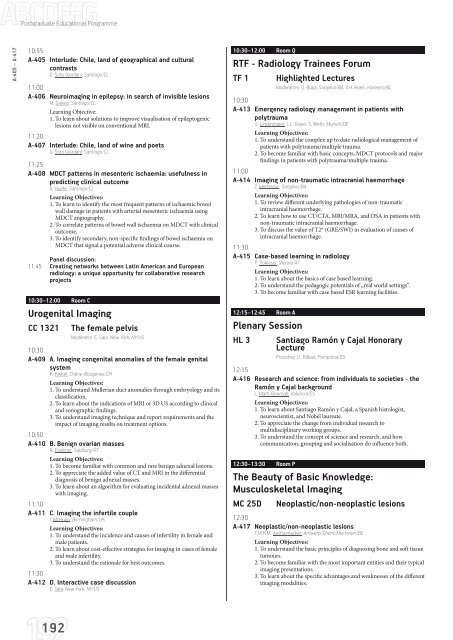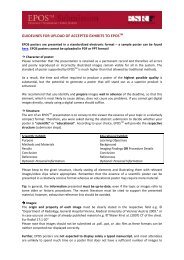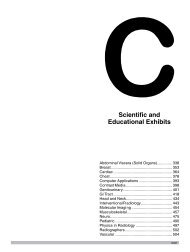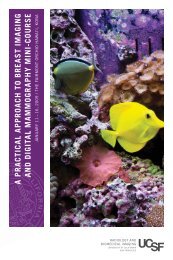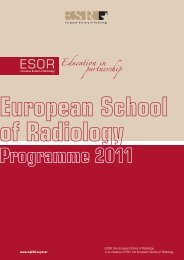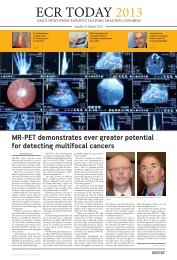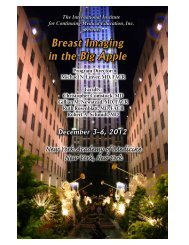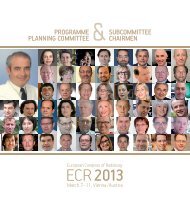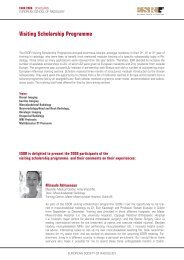ECR 2013 â Final Programme - myESR.org
ECR 2013 â Final Programme - myESR.org
ECR 2013 â Final Programme - myESR.org
- No tags were found...
Create successful ePaper yourself
Turn your PDF publications into a flip-book with our unique Google optimized e-Paper software.
Postgraduate Educational <strong>Programme</strong>A-405 – A-41710:55A-405 Interlude: Chile, land of geographical and culturalcontrastsG. Soto Giordani; Santiago/CL11:00A-406 Neuroimaging in epilepsy: in search of invisible lesionsM. Galvez; Santiago/CLLearning Objective:1. To learn about solutions to improve visualisation of epileptogeniclesions not visible on conventional MRI.11:20A-407 Interlude: Chile, land of wine and poetsG. Soto Giordani; Santiago/CL11:25A-408 MDCT patterns in mesenteric ischaemia: usefulness inpredicting clinical outcomeA. Huete; Santiago/CLLearning Objectives:1. To learn to identify the most frequent patterns of ischaemic bowelwall damage in patients with arterial mesenteric ischaemia usingMDCT angiography.2. To correlate patterns of bowel wall ischaemia on MDCT with clinicaloutcome.3. To identify secondary, non-specific findings of bowel ischaemia onMDCT that signal a potential adverse clinical course.Panel discussion:11:45 Creating networks between Latin American and Europeanradiology: a unique opportunity for collaborative researchprojects10:30–12:00 Room CUrogenital ImagingCC 1321 The female pelvisModerator: E. Sala; New York, NY/US10:30A-409 A. Imaging congenital anomalies of the female genitalsystemK. Kinkel; Chêne-Bougeries/CHLearning Objectives:1. To understand Mullerian duct anomalies through embryology and itsclassification.2. To learn about the indications of MRI or 3D US according to clinicaland sonographic findings.3. To understand imaging technique and report requirements and theimpact of imaging results on treatment options.10:50A-410 B. Benign ovarian massesR. Forstner; Salzburg/ATLearning Objectives:1. To become familiar with common and rare benign adnexal lesions.2. To appreciate the added value of CT and MRI in the differentialdiagnosis of benign adnexal masses.3. To learn about an algorithm for evaluating incidental adnexal masseswith imaging.11:10A-411 C. Imaging the infertile coupleJ. McHugo; Birmingham/UKLearning Objectives:1. To understand the incidence and causes of infertility in female andmale patients.2. To learn about cost-effective strategies for imaging in cases of femaleand male infertility.3. To understand the rationale for best outcomes.11:30A-412 D. Interactive case discussionE. Sala; New York, NY/US10:30–12:00 Room QRTF - Radiology Trainees ForumTF 1 Highlighted LecturesModerators: D. Bulja; Sarajevo/BA, V.H. Koen; Harleem/NL10:30A-413 Emergency radiology management in patients withpolytraumaU. Linsenmaier, L.L. Geyer, S. Wirth; Munich/DELearning Objectives:1. To understand the complex up to date radiological management ofpatients with polytrauma/multiple trauma.2. To become familiar with basic concepts, MDCT protocols and majorfindings in patients with polytrauma/multiple trauma.11:00A-414 Imaging of non-traumatic intracranial haemorrhageZ. Merhemic; Sarajevo/BALearning Objectives:1. To review different underlying pathologies of non-traumaticintracranial haemorrhage.2. To learn how to use CT/CTA, MRI/MRA, and DSA in patients withnon-traumatic intracranial haemorrhage.3. To discuss the value of T2* (GRE/SWI) in evaluation of causes ofintracranial haemorrhage.11:30A-415 Case-based learning in radiologyP. Pokieser; Vienna/ATLearning Objectives:1. To learn about the basics of case based learning.2. To understand the pedagogic potentials of „real world settings“.3. To become familiar with case based ESR learning facilities.12:15–12:45 Room APlenary SessionHL 3 Santiago Ramón y Cajal HonoraryLecturePresiding: J.I. Bilbao; Pamplona/ES12:15A-416 Research and science: from individuals to societies - theRamón y Cajal backgroundL. Martí-Bonmatí; Valencia/ESLearning Objectives:1. To learn about Santiago Ramón y Cajal, a Spanish histologist,neuroscientist, and Nobel laureate.2. To appreciate the change from individual research tomultidisciplinary working groups.3. To understand the concept of science and research, and howcommunication, grouping and socialisation do influence both.12:30–13:30 Room PThe Beauty of Basic Knowledge:Musculoskeletal ImagingMC 25D Neoplastic/non-neoplastic lesions12:30A-417 Neoplastic/non-neoplastic lesionsF.M.H.M. Vanhoenacker; Antwerp/Ghent/Mechelen/BELearning Objectives:1. To understand the basic principles of diagnosing bone and soft tissuetumours.2. To become familiar with the most important entities and their typicalimaging presentations.3. To learn about the specific advantages and weaknesses of the differentimaging modalities.192


